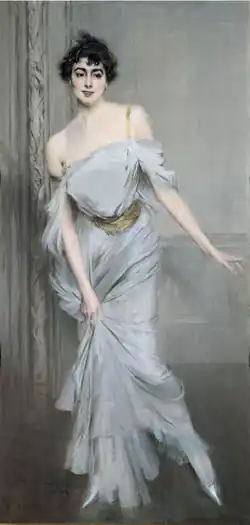| Madame Charles Max | |
|---|---|
 | |
| Artist | Giovanni Boldini |
| Year | 1896 |
| Medium | Oil on canvas |
| Dimensions | 203 cm × 100 cm (80 in × 39 in) |
| Location | Musée d'Orsay, Paris |
Madame Charles Max is an oil on canvas painting by the Italian painter Giovanni Boldini, from 1896. It is held in the Musée d'Orsay, in Paris.[1]
History
Boldini represents the beautiful and renowned society singer Jeanne Max (1869-1929), the wife of Jules Charles Max; she used to receive all the Parisian elite in her salon.
This full-length portrait was exhibited at the Salon of the Société nationale des beaux-arts. The critic François Thiébault-Sisson praised it: “In the scabrous art of accentuating, by the unexpectedness of movement, through the unexpected, often risky, pose, the grace and piquancy of his models, Boldini knows no rival."[2]
Description
In this portrait, the woman walks slightly towards the viewer, and shows an uninhibited, smiling and relaxed gaze. Madame Max wears a white dress, supported at the waist by a sash and at the shoulders by a single, thin stripe (the other appears to have provocatively slipped over her shoulder) and with a generous neckline. Boldini insists on the oval of the face, where the pink cheeks stand out, and in the tousled hairstyle. If the brushstrokes that draw the face are descriptive and attentive to detail, in the depiction of the dress, Boldini resorts to his famous "saber cuts": the regal evening dress, in fact, allows the use of long and delicate brushstrokes, with which the figure of Madame Max seems to acquire an unprecedented lightness. In the background, Boldini depicts a molded doorframe.[3][4]
Boldini carefully describes the anatomy of the character, as observed by art critics Giorgio Cricco and Francesco Di Teodoro, "the left leg is slightly raised, with the knee consequently advanced and the corresponding arm slenderly backwards, to balance the step, while the right hand skilfully gathers the long dress to further facilitate the gait."[5]
The model's unstable and dynamic pose exalts her sensuality. The painting is executed in white and gray tones; the framing reduces as much as possible the relationship of the figure with its environment and the surrounding objects.[6]
References
- ↑ Madame Charles Max, Musée d'Orsay
- ↑ Barbara Guidi, Servane Dargnies-de Vitry, Boldini. Les plaisirs et les jours, Paris, Paris Musées, March 2022 (French)
- ↑ Giorgio Cricco, Francesco Di Teodoro, Itinerario nell’arte, Dal Barocco al Postimpressionismo, Versione gialla, Bologna, Zanichelli, 2012 (Italian)
- ↑ Barbara Guidi, Servane Dargnies-de Vitry, Boldini. Les plaisirs et les jours, Paris, Paris Musées, March 2022 (French)
- ↑ Giorgio Cricco, Francesco Di Teodoro, Itinerario nell’arte, Dal Barocco al Postimpressionismo, Versione gialla, Bologna, Zanichelli, 2012 (Italian)
- ↑ Barbara Guidi, Servane Dargnies-de Vitry, Boldini. Les plaisirs et les jours, Paris, Paris Musées, March 2022 (French)